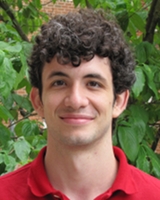2013 REU Program Participant Profiles: Christopher Oballe

|
Major: Mathematics and Biochemistry |
Why did you apply to the REU program?
I was told by one of my mathematics professors that participating in an REU was a worthwhile undertaking for anyone considering pursuing a career in academic research. Given that mathematical biology is an active field of research and synthesizes knowledge and skills from both of my areas of study, I wanted to gain some experience in the field. The NIMBioS program was a great fit because of its location and the wide variety of projects it offered. It was easy to find something interesting.
What is the purpose of your research?
If one looks at the genetic code, they'll find redundancy. That is, most amino acids correspond to multiple codons. However, though two given codons may code for the same amino acid, it does not necessarily imply that each codon type is equally prevalent throughout the genome. In fact, data supports the contrary notion. The goal of our research is to develop and analyze mathematical models to predict the extent of this codon usage bias in order to discover the biological mechanisms underlying the phenomenon.
What does the research ultimately accomplish? What contributions to science and/or humanity does the research ultimately make?
The research attempts to provide a thorough understanding of a fundamental biological process in terms of quantifiable variables. It's similar to looking for a physical law. I think it's neat because people don't always see how math can be used to provide an unambiguous, conceptual understanding of biology. Biology has a reputation amongst the public as a "math-free" science that requires rote memorization in order to be understood. In actuality, that's the furthest thing from the truth, and I think research like this is needed to demonstrate the utility of mathematics to understanding the natural world.
Describe a typical day on the job.
Work days begin around 9 and end around 5. Most days are spent looking through and modifying previous code developed by our mentor while simultaneously learning a new programing language, reading through research papers, and attempting to develop new ideas for modeling. In the future, we anticipate most of our time will be spent coding, testing, and analyzing a new model. A lot of preliminary work has to be done before we can successfully develop such a technical model. My group typically divides up work in such a way that utilizes the talents and interests of each team member. Most days, we meet up with our mentor to give a progress report and ask questions about confusing details.
What were your favorite parts of the REU program?
Obviously, it's a valuable learning experience since I want to attend graduate school, and I've loved working on an interesting problem. Making new friends and exploring the city has also been a blast as well. We play a lot of ultimate Frisbee, have been out to restaurants, farmer's markets, and music festivals, and we usually have a pot luck dinner in someone's room every weekend.
NIMBioS
1122 Volunteer Blvd., Suite 106
University of Tennessee
Knoxville,
TN 37996-3410
PH: (865) 974-9334
FAX: (865) 974-9461
Contact NIMBioS


